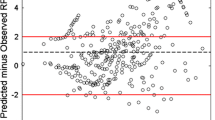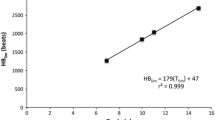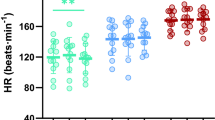Summary
An interesting aspect, when comparing athletes, is the effect ofspecialized training upon both physiological performance and perceptual responses. To study this, four groups (with six individuals each) served as subjects. Two of these consisted of highly specialized individuals (racing cyclists and marathon runners) and the other two of non-specialized individuals (sedentary and all-round trained). Cycling on a cycle ergometer and running on a treadmill were chosen as modes of exercise. Variables measured included heart rate, blood lactate and perceived exertion, rated on two different scales. Results show a linear increase of both heart rate and perceived exertion (rated on the RPE scale) in all four groups, although at different absolute levels. Blood lactate accumulation, during cycling and running, differentiates very clearly between the groups. When heart rate and perceived exertion were plotted against each other, the difference at the same subjective rating (RPE 15) between cycling and running amounted to about 15–20 beats · min−1 in the non-specialized groups. The cyclists exhibited almost no difference at all as compared to 40 beats · min−1 for the runners. It can be concluded that specialized training changes both the physiological as well as the psychological response to exercise.
Similar content being viewed by others
References
Åstrand P-O (1952) Experimental studies of physical working capacity in relation to sex and age. Munksgaard, Copenhagen
Åstrand P-O, Rodahl K (1986) Textbook of work physiology. McGraw Hill, New York, pp 325–331
Åstrand P-O, Ryhming I (1954) A nomogram for calculation of aerobic capacity (physical fitness) from pulse rate during submaximal work. J Appl Physiol 7:218–221
Borg G (1961) Interindividual scaling and perception of muscular force. Kungl Fys Sälls Förhand, Lund, pp 105–115
Borg G (1962) Physical performance and perceived exertion. Studia Psychologica et Paedagogica, Series altera, Investigationes XI. Gleerup, Lund, pp 1–25
Borg G (1970) Perceived exertion as an indicator of somatic stress. Scand J Rehabil Med 2:92–98
Borg G (1972) A ratio scaling method for interindividual comparisons. Reports from the Institute of Applied Psychology, University of Stockholm, no 27:1–10
Borg G (1982) A category scale with ratio properties for intermodal and interindividual comparisons. In: Geissler H-G, Petzold P (eds) Psychophysical judgement and the process of perception. VEB Deutscher Verlag der Wissenschaften, Berlin, pp 25–33
Borg G, Dahlström H (1959) A psychophysical investigation of work on cycle ergometers (in Swedish). Nord Med 62:1383–1386
Borg G, Dahlström H (1960) The perception of muscular work. Umeå Vetensk Bibl Skrifts 5:1–26
Borg G, Ottoson D (eds) (1986) The perception of exertion in physical work. Wenner-Gren Center Int Symp Series. MacMillan, London, pp 3–337
Borg G, Ljunggren G, Marks LE (1985) General and differential aspects of perceived exertion and loudness assessed by two new methods. University of Stockholm, Department of Psychology, Stockholm, no 636:1–13
Borg G, van den Burg M, Hassmén P, Kaijser L, Tanaka S (1987) Relationships between perceived exertion, HR and HLa in cycling, running and walking. Scand J Sports Sci 9:69–77
Carton RL, Rhodes EC (1985) A critical review of the literature on ratings scales for perceived exertion. Sports Med 2:198–222
Faulkner JA, Roberts DE, Elk RL, Conway JF (1971) Cardiovascular responses to submaximum and maximum effort cycling and running. J Appl Physiol 30:457–461
Glassford RG, Baycroft GHY, Sedgwick AW, Magnab RBJ (1965) Comparison of maximal oxygen uptake values determined by predicted and actual values. J Appl Physiol 20:509–513
Green HJ, Hughson RL, Orr GW, Ranney DA (1983) Anaerobic threshold, blood lactate, and muscle metabolites in progressive exercise. J Appl Physiol 54:1032–1038
Hohorst HJ (1962) L (+) Lactat-Bestimmung mit Lactat-Dehydro-Genase and DPN. In: Bergmeyer HV (ed) Methoden der enzymatischen Analyse. Verlag Chemie, Weinheim, pp 1–90
Kohrt WM, Morgan DW, Bates B, Skinner JS (1987) Physiological responses of triathletes to maximal swimming, cycling, and running. Med Sci Sports Exerc 19:51–55
McArdle WD, Magel JR, Delio DJ, Toner M, Chase JM (1978) Specificity of run training on Vozm.x and heart rate changes during running and swimming. Med Sci Sports Exerc 10:16–20
Mihevic PM (1981) Sensory cues for perceived exertion: a review. Med Sci Sports Exerc 3:150–163
Miyamura M, Kitamura K, Yamada A, Matsui H (1978) Cardiorespiratory responses to maximal treadmill and bicycle exercise in trained and untrained subjects. J Sports Med 18:25–32
Pandolf KB (1983) Advances in the study and application of perceived exertion. In: Terjung RL (ed) Exercise and sport sciences reviews, vol 11. Am Coll Sports Med Ser. Franklin Institute Press, Philadelphia, pp 119–158
Pannier JL, Vrijens J, VanCauter C (1980) Cardiorespiratory response to treadmill and bicycle exercise in runners. Eur J Appl Physiol 43:243–251
Pechar GS, McArdle WD, Katch FI, Magel JR, DeLuca J (1974) Specificity of cardiorespiratory adaptation to bicycle and treadmill training. J Appl Physiol 36:753–756
Roberts JA, Alspaugh JW (1972) Specificity of training effects resulting from programs of treadmill running and bicycle ergometer riding. Med Sci Sports Exerc 4:6–10
Rodahl K (1960) Muscle as a tissue. McGraw Hill, New York, pp 12–74
Saltin B (1986) Aerob — anaerob training. In: Forsberg A, Saltin B (eds) Konditionsträning. Idrottens Forskningsråd, Stockholm, pp 224–227
Saltin B, Astrand P-O (1967) Maximal oxygen uptake in athletes. J Appl Physiol 23:353–358
Sjödin A, Jacobs I (1981) Onset of blood lactate accumulation and marathon performance. Int J Sports Med 2:23–26
Stevens SS (1953) On the brightness of lights and the loudness of sounds. Science 118:576
Stevens SS (1957) On the psychophysical law. Psychol Rev 64:153–181
Stevens SS (1960) The psychophysics of sensory function. Am Sci 2:226–253
Stevens SS (1971) Sensory power functions and neural events. In: Loewenstein WR (ed) Handbook of sensory physiology, vol 1. Springer, New York Berlin Heidelberg, pp 226–242
Stevens SS, Galanter EH (1957) Ratio scales and category scales for a dozen perceptual continua. J Exp Psychol 54:377–411
Verstappen FTJ, Huppertz RM, Snoeckx LHEH (1982) Effect of training specificity on maximal treadmill and bicycle ergometer exercise. Int J Sports Med 3:43–46
Author information
Authors and Affiliations
Rights and permissions
About this article
Cite this article
Hassmén, P. Perceptual and physiological responses to cycling and running in groups of trained and untrained subjects. Europ. J. Appl. Physiol. 60, 445–451 (1990). https://doi.org/10.1007/BF00705035
Accepted:
Issue Date:
DOI: https://doi.org/10.1007/BF00705035




